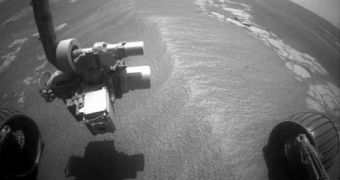The Mars Exploration Rovers (MER) program began in 2004, with the landing on Mars of the twin robots Spirit and Opportunity. Originally scheduled to roam the surface of the planet for little more than three months, both of them proved to be extremely resilient, and, against all odds, survived the harsh Martian winter not once, but four times. Now, engineers at NASA's Mission Control are celebrating Opportunity, which recently achieved it's 10-mile mark on its odometer. The enthusiasm is, however, clouded by the fact that, on the opposite side of the Red Planet, Spirit is stuck in loose terrain.
Yesterday, NASA announced that Opportunity exceeded the mark while driving for the Endeavor crater, after already studying two other similar formations. When the craft was first designed, no one thought that it would last this long. Naturally, not everything on the tiny robots works. For example, Spirit has a wheel that jammed some three years ago, and has since continually driven backwards. Opportunity has some damage on its moving parts, which limits its speed, but carries on nonetheless.
“For a vehicle that was designed to travel 1 km over its lifetime, going 16+ km is a pretty substantial accomplishment!” the MER Project Lead Scientist, Steve Squyres, who is based at the Cornell University, told Space in an interview. The two machines, which landed on Mars in January 2004, where scheduled to travel a short distance each, harvest soil samples and take panoramic pictures of their surroundings. However, each of them has outlived its purpose, and, in addition to the thousands of pictures they sent back, they gave their controllers a massive experience in dealing with problems.
This type of experience would be crucial for similar problems that may appear during other robotic exploration missions on Mars, the Moon, Ceres, or any other celestial body in the solar system. For example, the Mars Science Laboratory (MSL) rover designed by NASA and the ExoMars robot constructed by the European Space Agency (ESA) could both benefit from the expertise accumulated by these engineers and rover controllers and programmers.
Opportunity reported the achievement after a short drive on sol 1897. A sol is a Martian day, which is roughly 40 minutes longer than an Earth day. The rover traveled for about 50 meters (164 feet), and its total odometry now shows 16,133.96 meters or 10.025 miles.

 14 DAY TRIAL //
14 DAY TRIAL //